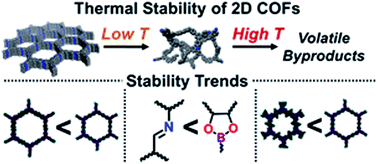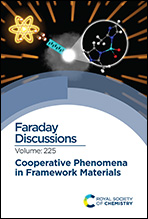Trends in the thermal stability of two-dimensional covalent organic frameworks†
Abstract
Two-dimensional covalent organic frameworks (2D COFs) are synthetically diverse, layered macromolecules. Their covalent lattices are thought to confer high thermal stability, which is typically evaluated with thermogravimetric analysis (TGA). However, TGA measures the temperature at which volatile degradation products are formed and is insensitive to changes of the periodic structure of the COF. Here, we study the thermal stability of ten 2D COFs using a combination of variable-temperature X-ray diffraction, TGA, diffuse reflectance infrared spectroscopy, and density functional theory calculations. We find that 2D COFs undergo a general two-step thermal degradation process. At the first degradation temperature, 2D COFs lose their crystallinity without chemical degradation. Then, at higher temperatures, they chemically degrade into volatile byproducts. Several trends emerge from this exploration of 2D COF stability. Boronate ester-linked COFs are generally more thermally stable than comparable imine-linked COFs. Smaller crystalline lattices are more robust to thermal degradation than chemically similar larger lattices. Finally, pore-functionalized COFs degrade at significantly lower temperatures than their unfunctionalized analogues. These trends offer design criteria for thermally resilient 2D COF materials. These findings will inform and encourage a broader exploration of mechanical deformation in 2D networks, providing a necessary step towards their practical use.

- This article is part of the themed collection: Cooperative phenomena in framework materials


 Please wait while we load your content...
Please wait while we load your content...